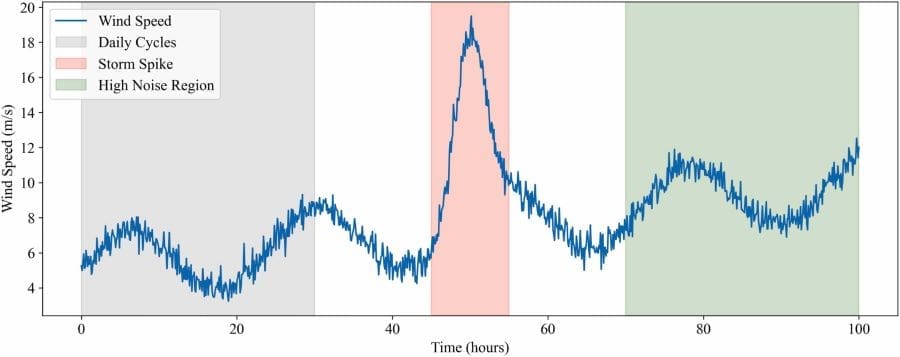Summary:
Short-term wind speed forecasting is vital to the smooth operation and efficient dispatch of wind power systems, but the irregular and multiscale nature of wind remains a major challenge for traditional models. In a review published in Advances in Wind Engineering, researchers from Central South University in China examine how artificial intelligence (AI) can improve prediction accuracy and system performance. The paper outlines a three-part analytical framework – decomposition, modeling, and optimization – designed to guide the development of intelligent wind forecasting systems.
The authors assess a range of signal decomposition methods, including empirical mode decomposition (EMD), variational mode decomposition (VMD), and wavelet-based approaches. These techniques help break down wind signals into components that are easier to model, allowing more accurate forecasts. They also review strategies for building hybrid models that combine shallow learning (to respond to short-term fluctuations) and deep learning (to capture longer-term patterns). Fusion methods such as stacking, boosting, and graph neural networks are shown to improve model robustness and flexibility.
Finally, the review evaluates multi-objective optimization algorithms like NSGA-II and MOPSO, which help balance accuracy, speed, and interpretability. The study offers a structured reference for researchers and engineers aiming to build practical, high-performance wind forecasting solutions.

Multiscale decomposition and hybrid models for wind forecasting
Wind speed forecasting plays a critical role in ensuring optimal operation and dispatch of power systems, especially with the global expansion of wind energy. However, the inherently nonstationary and multiscale nature of wind signals presents challenges for traditional statistical and single-model artificial intelligence (AI) methods.
In a new review, researchers from Central South University in China summarize recent progress in the application of AI to wind speed prediction.
“We offered a structured overview of how AI can contribute to forecasting systems that are not only accurate, but also stable, efficient, and practical for real-world deployment,” says Professor Hui Liu, lead author of the study.
The review was organized around a “decomposition–modeling–optimization” analytical framework. The researchers evaluated signal decomposition techniques such as empirical mode decomposition (EMD) and variational mode decomposition (VMD), analyzing their performance in isolating frequency bands for subsequent modeling. For example, the paper cites studies where VMD-based models achieved mean absolute percentage errors (MAPE) as low as 2.8% in winter forecasts – demonstrating improved stability over traditional methods.
“Following that, we examined existing intelligent fusion strategies, from simple ensemble averages to advanced architectures like stacking, boosting, and graph neural networks,” shares Liu. “These hybrid approaches are shown to enhance robustness by combining shallow models (for fast response to high-frequency fluctuations) with deep learning models (for long-term pattern extraction).”
The review emphasized the role of multi-objective optimization in balancing prediction accuracy, computational efficiency, and model interpretability. It discussed widely adopted algorithms such as NSGA-II and MOPSO, and their ability to support Pareto-optimal decision making in model configuration.
“This review lays a methodological foundation for developing intelligent, modular, and application-oriented wind forecasting systems, bridging recent AI advances with real-world engineering needs,” adds Liu.
Journal Reference:
Hui Liu, Rui Yang, ‘Artificial intelligence for wind speed forecasting: A review on multi-scale decomposition and intelligent fusion strategies’, Advances in Wind Engineering 2, 2: 100055 (2025). DOI: 10.1016/j.awe.2025.100055
Article Source:
Press Release/Material by KeAi Publishing
Featured image credit: Casey Horner | Unsplash




